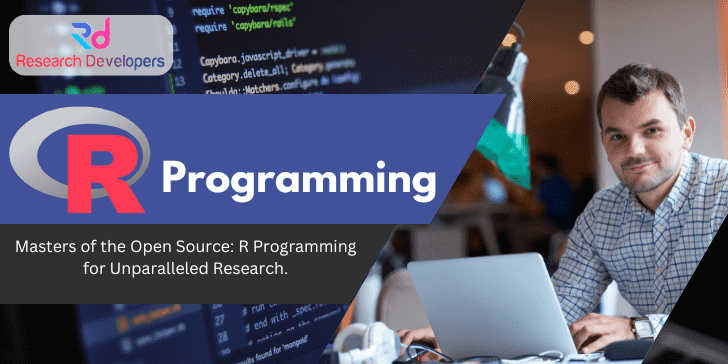R Programming
Where research begins: Expert guidance on topic selection.

R Programming
R is a programming language used to perform both simple and complex statistical studies. It has functions for graphical representation, data modeling, and data exploration and summary. This article aims to provide you a foundational level of proficiency in the language. It is advised that you open a R session and work through this paper on the computer. Enter each command that is printed, making sure you comprehend how it works. Next, attempt the basic tasks included at the conclusion of every segment.
When using R, you construct objects that are kept in the workspace that is currently open (often referred to as an image). Until you specifically remove it, every item that is produced stays in the image. If you don’t save the workspace before the session ends, it will be lost. By selecting the disk symbol located at the top of the control panel, you can save the workspace at any moment.
R commands are stored in memory for the duration of the session. Using the “up” and “down” arrow keys, you can scroll back to earlier commands that you typed. Additionally, you can “copy” and “paste” using common Windows editor methods (such by utilizing the “copy” and “paste” dialog boxes). You can save a copy of the commands you have used for future use by clicking on “File” and then “Save History” if you would like to preserve the transcript of your session at any time. Alternatively, you might manually copy and paste commands into an editor like Notepad or something comparable.
The development of S was followed by the widespread adoption of the R language. A significant constraint of the S language was its exclusive availability in the commercial package known as S-PLUS. Robert Gentleman and Ross Ihaka of the University of Auckland’s Department of Statistics established R in 1991. R was originally made available to the public in 1993. A 1996 paper by Ross Ihaka and Robert Gentleman published in the Journal of Computational and Graphical Statistics details their experience developing R. R: A language for graphic design and data analysis. 5(3):299–314, Journal of Computational and Graphical Statistics, 1996
When Martin Mächler convinced Ross and Robert to release R as free software in 1995, under the provisions of the GNU General Public Licence, it was a major contribution. This was significant since it made the source code for the entire R system being open to anybody who required to experiment with it (more on free software later).
A public mailing list, the R-devel lists and R-help, was established in 1996. A year later, in 1997, the R Core Group was established, comprising individuals connected to S and S-PLUS. As of right now, only the core group has the ability to check changes into the main R source tree and manage the source code for R. At last, The public was first allowed to access R version 1.0.0 in 2000.
R’s early syntax was quite close to S, which made it simple for S-PLUS users to transition. This was one of its main advantages. Although the syntax of R and S are almost the same, R’s semantics are very different from S’s, despite their seeming similarities. In terms of how R functions internally, it is actually far more similar to the Scheme language than it is to the actual S languages.
R is now compatible with nearly all modern operating systems and computing platforms. Because the software is open source, anyone can modify it to run on any platform they like. Indeed, it has been stated that R runs on contemporary gaming consoles, PDAs, tablets, and phones.
Regular releases are one good thing that R and many other well-known open source projects have in common. Every year, usually in October, there is a significant release that includes the public release of new features. Smaller-scale bugfix releases will be produced as needed throughout the year.
Regular release cycles and frequent releases show that the programme is actively being developed, and they guarantee that defects will be fixed promptly. Naturally, a large global community contributes new features, bug fixes, or both to R, even if the core developers maintain control over the main source tree.
advanced graphical capabilities remain a significant advantage over many other statistical tools, even in the modern era. Since its inception, R has been able to produce publication quality visuals that are typically superior to those of other packages. because trend persists now because there are a lot more visualisation packages accessible than there were previously.
Plots and graphs can be precisely customised in almost every way thanks to R’s basic graphics framework. More recent graphics tools, such as ggplot2 and lattice, provide intricate and sophisticated high-dimensional data visualisations.
The original S ideology has been upheld by R, which offers a language that is helpful for interactive work and includes a strong programming language for creating new tools. This enables the user to gradually transform into a developer who is producing new tools by applying already-existing tools to data.
Ultimately, one of the delights of utilising R is not the language per se, but rather the dynamic and engaged user base. A language is successful in many respects because it provides a platform on which a large number of individuals can produce new works. R is that platform, and hundreds of users have joined forces to develop packages, contribute to R, and support one another in using R for various applications. For more than ten years, the R-help and R-devel mailing lists have been extremely active, and there is a lot of activity on websites like Stack Overflow.
One of the main advantages of R over similar statistical tools is that it’s free—both in the sense of free software and free beer. The R Foundation owns the copyrights to the main source codes for R, which is released under the terms of the GNU General Public Licence version. The following four freedoms are yours to enjoy with free software, based on the Free Software Foundation.
• The ability to use the programme for whatever reason (freedom 0).
• The ability to examine the program’s operation and modify it to suit your demands (freedom 1). A prerequisite for this is having access to the source code.
• The ability to share copies with others in order to assist your neighbour (freedom 2).
• The ability to make changes to the programme and make them publicly available so that everyone in the community gains from them (freedom 3). Having access to the source code is a need.
To find out a great deal more about free software, go to the website of the Free Software Foundation. Richard Stallman started the Free Software Foundation in 1985. If you have some free time, you should check out Stallman’s personal website.
The Comprehensive R Archive Network, or CRAN, is the source of the main R system. Numerous add-on packages that can be used to increase R’s capability are also available on CRAN.
The R system consists of two conceptual components:
1. The R system that is “base” and can be downloaded from CRAN: Windows, Mac, Linux, and Source Code
2. Every other thing.
Other Services
- PHD & POST DOC Admission counselling
- Topic Section
- Review Paper Writing
- Systematic Literature Review (SLR)
- Research Paper Writing
- Synopsis Writing/Pre thesis writing
- Thesis Writing
- Data Analysis
- Questionnaire Preparation
- Developing Research Framework
- Methodology Development
- MATLAB Implementation
- Matlab Simulation
- Python Implementation
- Machine Learning Implementation
- Deep Learning Implementation
- VHDL Implementation
- Hadoop
- NS2 Implementation
- NS3 Implementation
- ArcGis Mapping & Analysis
- Spss Data Analysis
- Stata Data Analysis
- Amos Analysis
- R Programming
- E-Views Data Analysis
- Minitab Data Analysis
- Software Testing
- Ansys Implementation

